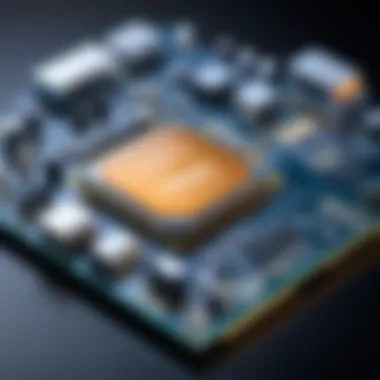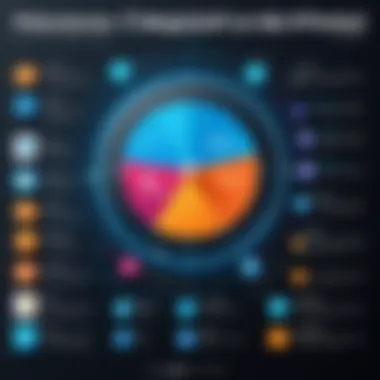The Evolution and Impact of Origin Graphics Software


Intro
The realm of graphics software has undergone significant transformation since its inception. Initially aimed at basic image manipulation, these applications have evolved into powerful tools that drive visual communication across numerous sectors. Understanding the evolution of graphics software is crucial for professionals in technology and business. This narrative will explore key features, milestones, and the broader implications of these tools in the modern landscape.
Key Features
Overview of Core Features
Graphics software today encompasses a range of capabilities fundamental for users. Some of these core features include:
- Image Editing: Powerful tools for retouching and editing images, allowing for detailed enhancements.
- 3D Modeling: Advanced software enables the creation of three-dimensional models, crucial in industries such as architecture and gaming.
- Graphic Design Tools: Features that support typography, layouts, and branding efforts, helping users construct visual narratives.
- Collaboration Functions: Many modern applications offer features for real-time collaboration, facilitating team projects and workflow efficiencies.
Understanding these core features aids in selecting the right software for specific tasks, enabling users to leverage technology effectively for their goals.
User Interface and Experience
User interface (UI) and experience (UX) are essential aspects of any graphics software. Tailored designs can significantly impact productivity and satisfaction. Modern graphics software focuses on:
- Intuitive Layouts: Clear, organized interfaces help users navigate tools and options seamlessly.
- Customization Options: Users can often personalize their workspace to optimize efficiency based on their unique workflows.
- Responsive Design: Software is designed to work on various devices, from desktops to tablets, ensuring flexibility in usage.
Pricing and Plans
Overview of Pricing Models
The pricing of graphics software varies widely, with several models available:
- One-Time Purchase: Users pay once for lifetime access, typically seen in traditional desktop programs.
- Subscription-Based: Monthly or annual fees offer access to updates and new features, popular in many modern tools.
This variety allows businesses and individuals to choose plans that best suit their financial and operational needs.
Comparison of Different Plans
Different software options provide various pricing tiers. It is helpful to compare capabilities and costs:
- Basic Plans: Generally include core features, suitable for casual users.
- Standard Plans: Additional features for more serious users and professionals.
- Premium Plans: All features included, catering to businesses and advanced users with higher demands.
Choosing the right plan requires assessing individual or team needs thoroughly, as well as future growth potential.
“The evolution of graphics software reflects broader technological advancements, influencing how we create and communicate visually.”
Overall, the journey of graphics software is a testament to innovation and usability, shaping how various industries harness visual communication in our digitized world.
Foreword to Graphics Software
The realm of graphics software has transformed remarkably, impacting industries and personal creativity alike. Understanding this evolution is essential to appreciate its significance in today's digital landscape. Graphics software encompasses a diverse range of applications and tools, driving creative expression and innovation. By training readers on its origins and evolution, we aim to illuminate the path that connects early efforts with modern capabilities.
Definition and Purpose
Graphics software refers to programs that allow users to create, edit, and manipulate visual content. This includes raster graphics, vector graphics, 3D modeling, and rendering. The primary purpose of these tools is to enable designers, artists, and developers to bring concepts to life visually. Each category of graphics software serves a unique function, supporting various industries from entertainment to architecture.
The power of graphics software lies in its versatility. Programs like Adobe Photoshop and Illustrator focus on image editing and vector creation, while others like Blender and Autodesk Maya cater to 3D modeling and animation. These tools facilitate creativity and provide users with the means to convey ideas effectively. In essence, graphics software is fundamental in bridging the gap between imagination and visual representation.
Importance in the Digital Age
In the digital age, the significance of graphics software cannot be overstated. It plays a crucial role in how we communicate and express ideas visually. With businesses increasingly relying on visual content for marketing and branding, the demand for effective graphics software has surged. This proliferation has led to significant advancements in user interface design and functionality, enabling more people to engage with these powerful tools.


Furthermore, graphics software extends beyond traditional applications. In game development, for example, it shapes user experiences through immersive environments and characters. Medical imaging relies on advanced graphics software for accurate diagnostics. Moreover, architectural visualization helps clients grasp complex designs before construction begins.
"Graphics software is not just tools; they are platforms for creativity and innovation that shape our interactions with the digital world."
Embracing these tools also brings challenges. Understanding hardware limitations and ensuring software compatibility remain important for users. Despite these hurdles, graphics software continues to evolve, integrating new technologies like AI and machine learning, to enhance its capabilities further.
Historical Context of Graphics Software
Understanding the historical context of graphics software is crucial for appreciating its current state and future direction. The evolution of the graphics software industry reflects a broader narrative of technological advancement, revealing how early innovations laid the groundwork for the powerful tools we use today. By examining the trajectory of graphics software, one can grasp the challenges faced by developers and the solutions they crafted in response.
Early Developments in Computer Graphics
The early days of computer graphics were marked by a quest for visualization. In the 1960s, computers were primarily utilized for computation and data processing. However, innovative thinkers started to explore visual representations of data, leading to the advent of the first graphics software. During this period, devices like the Sketchpad, created by Ivan Sutherland in 1963, enabled users to interact with graphical data directly. This was a significant departure from text-based computing.
Furthermore, applications began to emerge. Basic image processing, simple animations, and even rudimentary simulations became possible. The development of hardware also played a pivotal role. Graphical displays improved, and the advent of raster graphics enabled more sophisticated visual outputs. These advancements in the realm of graphics software were foundational, influencing both artistic and practical applications in the ensuing years.
The Role of Pioneers in Graphics Technology
The narrative of graphics software is incomplete without acknowledging the key figures whose pioneering efforts propelled its evolution. Innovators such as Alvy Ray Smith, who co-founded Pixar, and John Warnock of Adobe Systems significantly influenced how graphics software would develop. Their contributions cannot be overstated.
Alvy Ray Smith played a role in the intersection of art and technology, promoting the use of digital tools for animated films. Meanwhile, John Warnock's introduction of PostScript in 1985 revolutionized desktop publishing and shaped how text and images interacted on printed media. Both individuals exemplified how visionaries could transform abstract ideas into practical applications.
The synergy of computer science and artistic vision became a hallmark of graphic software. It opened avenues for creativity, allowing artistic expressions once confined to traditional media to expand into the digital realm. Thus, the role of these pioneers is not only about individual achievements but also about how they collectively advanced the field, steering it towards where we find ourselves today.
"The history of graphics software is a reflection of human imagination and technological progress, shaping the way we visualize and communicate our ideas."
The integration of these early developments and pioneering spirits set the stage for future innovations. As hardware improved and new algorithms emerged, graphics software evolved to meet diverse industry needs. This historical context serves as a foundation for understanding the complexities and advancements that shaped modern graphics software.
Key Innovations in Graphics Software
Key innovations in graphics software are foundational to understanding how visual communication has transformed in the digital age. This section explores critical advancements that set the stage for modern graphics applications. Each innovation has a unique significance, shaping design practices and influencing various industries.
Bitmap vs. Vector Graphics
Bitmap and vector graphics serve distinct purposes in the world of design. Bitmap graphics, or raster images, consist of pixels. Each pixel holds color information, creating detailed pictures. This method captures rich colors, making bitmaps ideal for photographs. However, their quality diminishes when scaled up, leading to pixelation. Common formats include JPEG, GIF, and PNG.
In contrast, vector graphics utilize paths, defined by a start and endpoint. They can be scaled infinitely without losing quality. This feature makes them suitable for logos and illustrations used in various sizes. Formats like SVG, EPS, and PDF are examples of vector images. Both types of graphics play vital roles, depending on the application, whether it's for print or digital.
Rendering Techniques
Rendering techniques are crucial for translating digital models into visual representations. The process involves converting information into an image. There are various methods, including:
- Ray Tracing: This technique simulates how light behaves in real life. It produces highly realistic images but requires significant computing power.
- Rasterization: Unlike ray tracing, rasterization is quicker and converts vector images into bitmaps. It is widely used in video games and real-time graphics.
- Scanline Rendering: This method processes one horizontal line of the image at a time. It is efficient for producing images but may lack the realism of ray tracing.
Each rendering technique has its merits, with applications ranging from animation to architectural visualization. Choices depend on the desired balance between quality and processing resource demands.
User Interface Design Evolution
User interface design has evolved dramatically with graphics software. Early interfaces were simple and often text-based. Over time, graphical user interfaces (GUIs) emerged, integrating visuals with functionality. This progression allows more intuitive interactions.
Modern GUI principles focus on user experience. Designers consider aspects such as:
- Usability: Interfaces must be easy to navigate.
- Accessibility: Software should be usable by all individuals.
- Aesthetic Appeal: Attractive designs enhance engagement and satisfaction.
Notable tools have emerged in this area, including Adobe XD and Sketch. These platforms help designers create prototype interfaces efficiently. The shift toward mobile and responsive design further influences user interface development today.


"The evolution of graphics software reflects broader technological progress and societal changes, significantly impacting how we communicate visually."
In summary, understanding key innovations in graphics software is essential for grasping their far-reaching implications in our increasingly digital world. Each evolution informs current practices and opens avenues for future advancements.
Application Areas of Graphics Software
Understanding the application areas of graphics software is essential in recognizing its influence across various fields. From enhancing creativity in visual arts to revolutionizing medical imaging, graphics software has become a pivotal tool in professional and personal domains alike.
Digital Art and Illustration
Digital art and illustration stand as one of the foremost applications of graphics software. Artists now harness programs like Adobe Photoshop and Corel Painter to create stunning visuals that were nearly impossible to achieve using traditional methods alone. The flexibility that digital tools provide enables creators to experiment without the constraints of physical materials.
The integration of layers, brushes, and effects within graphics software allows artists to produce intricate designs, adjusting elements swiftly until perfection is achieved. Moreover, the ability to share works instantly on platforms such as Behance and DeviantArt has fostered a global community, enabling artists to gain traction without the traditional gatekeeping of galleries.
Game Development
Game development has transformed remarkably with the advent of advanced graphics software. Tools like Unreal Engine and Unity have not only simplified the development processes but also enhanced the immersive experience of video games. Graphics software is crucial in creating the striking visuals, animations, and special effects that captivate players.
Developers can prototype ideas quickly, incorporating real-time feedback and iterations into the design. This flexibility accelerates the development cycle without sacrificing quality. As graphics technology evolves, the level of realism in games increases, leading to more engaging narratives that keep players returning for more.
Medical Imaging
In the medical field, graphics software has become indispensable. Advanced applications like 3D Slicer and OsiriX aid in interpreting complex data from medical imaging technologies such as MRI and CT scans. These tools allow practitioners to visualize data in innovative ways, improving diagnostics and patient outcomes.
The precision and clarity of graphics software in medical imaging enhance understanding among professionals. High-resolution images assist in surgical planning and simulations, making procedures safer and more effective. Ongoing developments in this area promise enhanced integration with artificial intelligence to further improve diagnostics.
Architectural Visualization
Architectural visualization is another significant application of graphics software. Programs like Autodesk Revit and SketchUp enable architects to create highly detailed, three-dimensional models of their designs. These visualizations can communicate concepts to clients and stakeholders clearly, helping to avoid misunderstandings.
Using these tools, architects can simulate environments in various conditions, showcasing how designs interact with light, space, and materials. This forward-thinking approach not only aids in design communication but also informs decisions regarding sustainability and efficiency, as visual evidence can influence final builds.
In summary, the multifaceted applications of graphics software span creative, technical, and practical fields. It shapes professional standards and offers avenues for innovation.
Through each of these application areas, graphics software exemplifies its evolving role in enhancing both artistry and functionality in our daily lives.
Current Trends in Graphics Software
The landscape of graphics software today is marked by rapid innovation. These trends demonstrate how technology is evolving and reshaping industries. Understanding these trends is crucial for anyone involved in graphics design, software development, or related fields. Not only do these advancements aid in enhancing creative processes, but they also improve efficiency and collaboration across various platforms. This section will focus on three pivotal trends: AI and machine learning integration, real-time rendering, and collaboration tools in graphics software.
AI and Machine Learning Integration
The integration of artificial intelligence and machine learning into graphics software is revolutionizing how designers and artists create. AI algorithms now assist in various tasks. For instance, Adobe Photoshop utilizes AI-driven features like Adobe Sensei. This enables users to perform complex editing tasks with greater speed and accuracy. AI can also analyze user behavior to suggest tools and enhancements.
Furthermore, machine learning models enable predictive rendering. This means they can forecast the necessary adjustments based on user inputs. Developers can now create smarter tools that adapt to individual workflows. Such capabilities lead to improved outcomes and greater user satisfaction.
Real-Time Rendering
Another focal trend in graphics software is real-time rendering. Traditionally, rendering was a time-intensive task requiring significant computing power. However, advances in hardware and software have made it possible to provide rendering results instantaneously. Real-time rendering is critical in industries such as gaming and virtual reality, where immersive experiences are essential.
With tools like Unreal Engine and Unity, developers can preview their graphics in real-time. This speed of rendering accelerates the production processes and allows for immediate feedback on changes. The impact stretches beyond gaming into fields like architectural visualization, where real-time feedback enhances presentations and client interactions.
Collaboration Tools in Graphics Software
Collaboration is an increasingly important aspect of graphics software. As more projects involve teams spread across various locations, effective tools are necessary. Modern graphics software offers a range of collaboration features. These include cloud-based platforms that allow multiple users to work on a project simultaneously.


Software applications such as Figma and Adobe Creative Cloud facilitate real-time teamwork. Designers can share their work instantly, receive feedback, and make adjustments on the fly. This enhances productivity and fosters creativity through collective input.
In summary, current trends in graphics software reflect significant shifts toward automation, efficiency, and collaboration. These changes indicate a dynamic future where technology continues to drive innovation in the graphics sector, ultimately benefiting users in various industries.
Challenges Faced by Graphics Software Development
The development of graphics software is a complex process intertwined with numerous challenges. Understanding these challenges is crucial for anyone involved in the field, as they directly impact the efficiency and effectiveness of graphics applications. When developers confront these obstacles, they must find solutions that align with technological advancements while responding to user demands. This section meticulously examines two primary challenges: hardware limitations and software compatibility issues. Both are significant hindrances that can thwart the innovative potential of graphics software.
Hardware Limitations
Hardware limitations present a formidable barrier in graphics software development. The demand for increasingly advanced graphic features—such as high-resolution rendering, complex visual effects, and real-time processing—requires powerful hardware capabilities. However, not all users have access to cutting-edge technology. This disparity creates a gap between the capabilities of the software and the hardware it operates on.
- Performance Variability: Different users may have varying hardware configurations, causing inconsistencies in software performance. For example, a high-end gaming PC may seamlessly run a graphics-intensive application, while a modest laptop faces significant lag or crashes.
- Cost Considerations: The financial implications of continuously upgrading hardware can deter users and developers alike. If end-users cannot afford better hardware, developers may face pressure to optimize their software for outdated systems, limiting their creative capabilities.
- Emerging Technologies: As new technologies like virtual reality and augmented reality evolve, they necessitate even more advanced hardware to deliver optimal performance. Graphics software must keep pace with these demands, adding to the complexity and resource requirements.
Software Compatibility Issues
Another prominent challenge is the compatibility of graphics software with diverse operating systems and devices. The software development landscape often involves ensuring that applications run smoothly across different platforms, such as Windows, macOS, and Linux.
- Diverse Ecosystem: The existence of myriad operating systems and their various versions introduces potential bugs and inconsistent behavior. Developers must invest substantial time to test and refine applications in multiple environments, which can slow down the release of their software.
- Legacy Support: Many applications still need to support older versions of operating systems. This support can stretch development resources thin and complicate the software architecture.
- Third-party Integration: Graphics software frequently relies on third-party plugins and libraries. When these components lack regular updates or are incompatible with the primary software, it can lead to technical difficulties, hindering user productivity and experience.
Addressing these challenges in graphics software development is essential for fostering innovation and enhancing user satisfaction. As the technology landscape evolves, so must the strategies developers employ to navigate these hurdles efficiently.
The Future of Graphics Software
The future of graphics software is pivotal in addressing the advanced needs of industries heavily reliant on visual communication. As technology evolves, the expectations from graphics software also change. The convergence of enhanced computational power and innovative algorithms is fueling new possibilities. This section explores key emerging technologies and offers predictions for future developments.
Emerging Technologies
The advent of emerging technologies is redefining the landscape of graphics software. Notably, areas such as augmented reality (AR) and virtual reality (VR) are gaining traction. The integration of AR in various applications enables users to interact with digital elements in real-world environments. On the other hand, VR provides immersive experiences, revolutionizing fields from gaming to education.
In addition, advancements in artificial intelligence (AI) are facilitating automated processes in design and rendering. AI algorithms can predict user behavior, thus streamlining workflows and enhancing efficiency. Such capabilities will likely lead to more personalized graphic design solutions, making the software more user-friendly.
Moreover, real-time ray tracing technology is becoming mainstream, enhancing visual fidelity in graphics rendering. This technique simulates the way light interacts with objects, thus creating more realistic images. As hardware capabilities improve, the effectiveness of real-time ray tracing will likely expand, providing greater detail and immersion.
Predictions for Future Developments
Looking ahead, several key predictions can be made regarding the future of graphics software. First, the trend toward cloud-based solutions will likely escalate. This will facilitate collaboration among users, as well as provide access to powerful computing resources without the need for expensive hardware.
Second, the integration of machine learning within graphics software will enhance design tools. As these systems learn from user interactions and design patterns, they will adapt to provide more tailored suggestions, thus expediting the creative process.
Third, we may witness a shift towards increased interactivity in graphics applications. Advanced user interface designs will allow for more intuitive manipulation of graphic elements, encouraging creativity and innovation.
"As industries embrace digital transformation, the role of graphics software will become increasingly central to operational success."
Finally, sustainability will emerge as a key consideration. As organizations prioritize eco-friendly practices, graphics software will need to adjust, offering solutions that minimize environmental impact. This may include optimizing rendering processes to reduce energy consumption.
In summary, the future of graphics software is tied to technological advancements and changing user needs. Emerging technologies will play a crucial role in shaping this future, while strategic adaptations will ensure graphics software remains relevant in an ever-evolving landscape.
Closure
In this article, the conclusion emphasizes the pivotal role graphics software has played in shaping the modern visual landscape. It crystallizes how past innovations have influenced current practices and foresees the implications for the future. The evolution of graphics software is not just a timeline of technological advancements; it reflects the changing needs of users and industries alike.
Summary of Key Points
The significance of graphics software can be distilled into several key points:
- Historical Progression: Understanding the origins and historical milestones of graphics software reveals how early challenges were navigated and overcome.
- Technological Innovations: Key innovations, such as the introduction of vector graphics and advanced rendering techniques, have paved the way for high-quality digital visuals.
- Applications Across Fields: Graphics software finds applications in diverse areas like digital art, gaming, medicine, and architecture, showcasing its importance in various sectors.
- Current Trends: The integration of AI and real-time rendering reflects a shift towards more responsive and adaptive visual design processes.
- Future Predictions: Anticipating emerging technologies and future developments in graphics software helps professionals stay ahead in a competitive landscape.
Final Thoughts on Graphics Software Evolution
The evolution of graphics software is an ongoing journey. As technologies advance, the capabilities of software continue to expand. This evolution not only influences creative expression but also impacts business strategies and user experiences. For professionals and businesses, understanding these dynamics is crucial. It allows for better adaptation to trends and informs decision-making processes, ensuring relevance in a rapidly evolving field.
"Graphics software is not merely a tool; it is a gateway to innovation and effectiveness across various domains."







